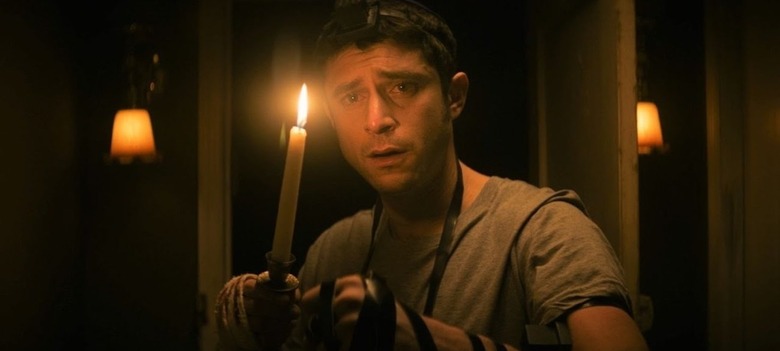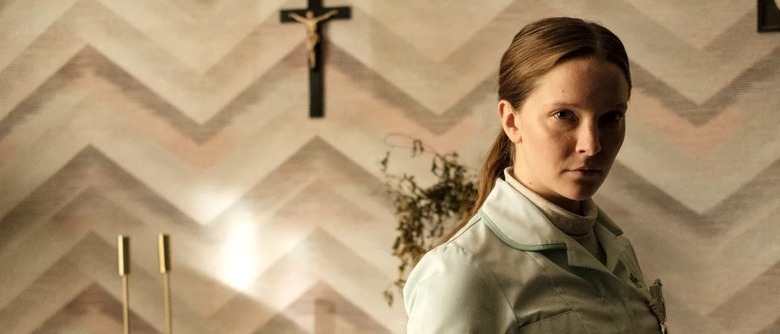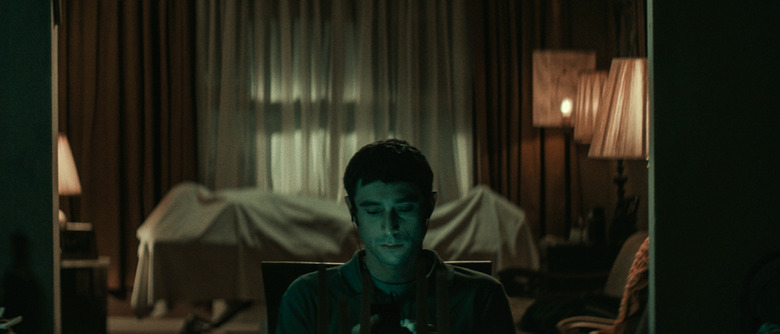How 'The Vigil' And 'Saint Maud' Use Horror To Explore The Nexus Between Religion, Trauma, And Mental Health
Being alone indoors is a common facet of pandemic life, but in The Vigil and Saint Maud, it's also a recipe for religious horror. These two films, which recently hit VOD and streaming, bend in opposite directions yet are cut from the same cloth. Both have first-time writer-directors at the helm and both are distributed by indie-horror labels (IFC Midnight and A24, respectively). Moreover, both center on an isolated individual who comes to believe that a supernatural force is reaching out to them. In The Vigil, it's a demon from Jewish folklore, the mazzik. In Saint Maud, it's a Welsh-speaking version of God himself.
Throw in a twitchy dead body under a white sheet, and a bed-ridden woman who's ready to go Regan MacNeil on you, and you might think you were in store for a schlocky double feature. We've seen plenty of flicks like that (not naming any names, but there's a whole subgenre of exorcism movies, many of which carry abysmally low Tomatometer scores.) What separates The Vigil and Saint Maud from those and unites them as thematic cousins is their serious-minded depiction of trauma and mental health.
Sitting The Vigil
Golems and dybbuks have featured on celluloid before, but as The Vigil opens, a new shadow from Jewish demonology comes shambling out of the mist: that of the mazzik, a monstrous pain parasite with a backwards-facing head. It's on a collision course with Yakov (Dave Davis), a young Brooklynite struggling to reintegrate into society after leaving his Hasidic community. In the bathroom mirror, he pops a pill before rejoining the members of his support group, who sit around the table, wearing yarmulkes and speaking English peppered with Yiddish.
Here, we learn that Yakov lacks basic life skills; he showed up for a job interview without a resume and tried to write one for himself on loose paper when they asked for it. Hugging people, exchanging contact information, and using the flashlight on his phone (mark that as Chekhov's flashlight) are all new to him. Later, we'll see him googling "how to talk to women."
"I just want to be normal," he says.
"And a big part of that is letting go," the group leader says. "Letting go of the pain, the trauma, that holds you back."
Already, the movie has stated its theme. This is a lean 89-minute feature, so less than ten minutes in, we move from the setup about Yakov to the catalyst that sets his harrowing one-night adventure in motion.
His former rabbi waits for him outside the support group meeting, leaning under the lamppost in his black hat and coat in a subtle visual nod to The Exorcist. Yakov's bleak financial situation has him choosing between medication and meals, and this is how the rabbi ropes him into being a shomer, a sort of night watchman who "sits the vigil" over a deceased person before their hearse arrives in the morning. The body, in this case, belongs to a recluse whose previous shomer got spooked and backed out at the last minute.
Suffice it to say, being trapped in the house with a fresh corpse, a widow with dementia, and an entity that feasts on agony can lead to some interesting turns. The Vigil holds a few funhouse scares that might make you jump, and there are some genuinely creepy moments involving Yakov's phone communications and an old basement recording. After watching so many vampire-hunters wield crucifixes in the movies, there's also a certain novelty to seeing a Jewish man wrap his head and arms in tefillin to go burn the face off a demon.
However, somewhere between the ominous music, the quiet stretches where Yakov sits texting, and the unique cultural trappings of a Jewish horror film, there's an affecting slice of drama about a man with PTSD. As the supernatural occurrences mount, Yakov reacts by phoning his therapist, convinced that he is having some kind of hallucinatory episode. "It's worse than it's ever been before," he says. The reason he left his community comes into focus via flashback: it was a move grounded in deep personal trauma. An antisemitic street encounter that led to worse tragedy has left him carrying some enormous baggage.
The Vigil is a film about human anguish and overcoming the past. It just happens to be couched in horror tropes and the specifics of multi-generational Jewish suffering. Among other things, the script references the Kiev pogroms of 1919 and the Buchenwald concentration camp in Nazi Germany. Filmmaker Keith Thomas draws a direct line from Holocaust survivors to hate crime victims, showing how people are broken first by violence, then by guilt. Through it all, lurks the mazzik, the creature that looks back on its own footsteps and attaches itself to a human host who does the same.
The Entropy of Saint Maud
Trauma is what causes Yakov to lose his religion, whereas, in Saint Maud (available on Epix), the title character finds herself undergoing a conversion after the fact. She's a nurse left damaged by an incident where she failed to save the life of a hospital patient.
Voiceovers take the form of prayers as Maud (Morfydd Clark) dines alone in her depressing one-room apartment. There's even less to show of her life than Yakov's before the inciting incident occurs. At her two-seat kitchenette table, she crosses herself, folds her hands, and begins, "Dear God" ... but this isn't The Color Purple. It's more like The Color Red, as in, boiling tomato soup or blood-stained white robes.
Ascending the steps to a cliffside mansion, Maud meets her new irreverent outpatient, Amanda (Jennifer Ehle), a dancer and choreographer now riddled with cancer. During physical therapy, Amanda assumes a Jesus Christ pose on the floor. Yet she fears that nothingness awaits her and she only seems to entertain the notion of Maud's God as an escape from boredom.
It seems cliche to apply the "slow burn" label, but this is one of those movies where the horror is more of a mood, bathed in sickly green lights and a portentous musical score. For the better part of 83 minutes, it simmers below the character drama as the film shifts the viewer's sympathies from one woman's perspective to another. There are times when Amanda comes off more like a wicked stepmother to Maud, the Cinderella who bathes her, wheels her around the house, and is left to scrub her vomit off the carpet after one of her late-night party sessions.
Amanda calls Maud her "little savior," and Maud latches onto that and makes it her mission to save her soul. Almost immediately, she finds herself competing for Amanda's affections, which only exacerbates her loneliness since she doesn't have the same support network around her that Yakov does. We never see Maud at church, talking to a minister, reading the Bible, or receiving any spiritual guidance. If hers is a faith forged by trauma, it's also one with no outside input to nourish it.
She mistakes her inner monologue for a dialogue. This leaves her denying reality while worshipping an imaginary friend or God of her own design. The real horror in Saint Maud is that of a closed belief system, which can only entropy, the way closed systems do. Cut off from any other meaningful human fellowship, Maud's belief takes the form of a festering psychosis.
She talks to God ... and God starts talking back to her in an audible fashion. His spirit, as she perceives it, shivers and pulses through her body, giving her orgasmic experiences. It's not without a masochistic streak, either. The first hint of this comes when we see her kneeling on popcorn seeds before she prays. Filmmaker Rose Glass has cited Taxi Driver as an influence but Saint Maud brings to mind another, more recent Paul Schrader script: namely, First Reformed.
On the streets at night, Maud gives money to panhandlers and blesses them, but the tone of her prayers and her words betray a conceited quality. As the audience, we have a window into her mind and can see the hubris in how she views herself and others.
"I have little time for creative types as they tend to be rather self-involved," she prays. And, "Don't get me wrong, palliative care is noble work, but I always knew you had something more planned for me. It takes nothing special to mop up after the decrepit and the dying. But to save a soul, that's quite something."
There's a key moment in the film when a friendly face shows up on Maud's doorstep. It's like the universe or God has put this person in front of her to be a guardian angel in human form. However, Maud turns her back to her and tunes out what she's saying. Instead of being in conversation with life, she's out of synch with it, having her own one-way conversation with herself. Maud talks but when it matters most, she doesn't listen, because she's so wrapped up in herself that she doesn't have ears to hear.
Saint Maud is a film that understands the psychology of a certain kind of solipsistic believer. In reality, Maud isn't very saintly but she's convinced the clouds will part and she will ascend into heaven like Christ himself. She embodies the paradox of the person who goes out and transgresses in epic fashion at night and then wakes up the next morning and thinks they are saved and called and chosen to do God's work.
Parables of Religious Horror
Some see horror in religion; others see religion in horror. They're not necessarily mutually exclusive viewpoints. Both deal with death and the unknown. In some ways, films like The Vigil and Saint Maud might even be closer to the spirit of biblical parables than most faith-based movies, insofar as they take an artful approach to delivering their themes rather than being openly didactic.
One of the basic underpinnings of Judeo-Christian belief is that human beings are subject to spiritual influence. You don't have to be hearing voices to appreciate how outside factors can affect a person's mental state.
The Vigil and Saint Maud offer two different tableaus of a believer beset by forces beyond their understanding. Because these are movies — indie dramas with a horror bent — each character's internal struggle manifests itself in visual terrors. Their survival or self-destruction depends on their ability to confront their own inner demons in a healthy manner.
The Vigil shows a character who has lost his faith because it carries painful associations, but who ultimately needs it back, if only for one night, to overcome the darkness in his own mind. Saint Maud shows a character who takes false refuge in her own faulty conceptions of the divine, following them down a path away from the truth, refusing to meet her situation head-on.
Yakov and Maud are inverses of each other. He faces himself in a narrow corridor; she looks to the sky on an open beach. At a time when people around the globe are more physically isolated or "socially distant" than ever, maybe there's a lesson to be drawn from these two films and their diverging portraits of stray minds seeking peace and purpose in a hostile world.



